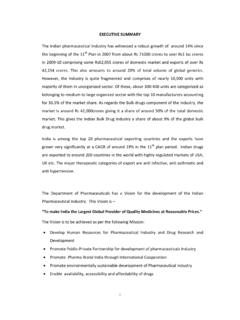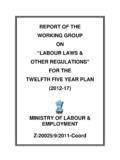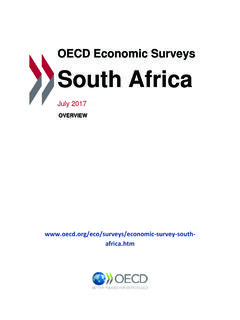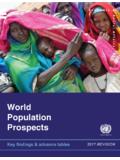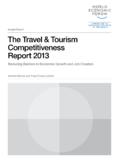Transcription of Employment and Skill Development - Planning …
1 Th e Eleventh Five Year Plan viewed the generation of productive and gainful Employment with decent working conditions on a suffi cient scale to absorb our growing labour force as a critical element in the strategy for achieving inclusive growth. Specifi cally, the Eleventh Plan (2007 12) aimed at generating 58 million work opportunities against the aggregate Employment generation of 47 million work opportuni-ties during the period 1999 2000 to 2004 05. Th e data on total Employment come from the results of the quinquennial surveys conducted by NSSO of which the last survey was for 2004 05.
2 Th e next is for 2009 10, the results of which will be available only in 2011. It is, therefore, not possible to provide reliable estimates at this stage of the pace of Employment creation beyond 2004 05. An assessment of the performance on the Employment front in the Mid-Term Assessment, therefore, has to be based on indirect indicators, which have a bearing on Employment growth. IMPACT OF GLOBAL SLOWDOWN ON Th e global fi nancial crisis, which erupted in 2008 and led to a slowdown in the economy, was bound to have an adverse eff ect on the Employment situation compared with what would have prevailed under normal circumstances.
3 According to the economic Survey 2009 10, Employment in the organized sector increased from lakh persons in 2004 05 to lakh persons in 2006 07 (that is, an increase of only per cent). Th e entire increase emanated 9 Employment and Skill Developmentfrom the organized private sector wherein employ-ment increased from lakh persons to lakh persons during the same period. Employment in the organized public sector remained stagnant at lakh Th e Labour Bureau of the Ministry of Labour and Employment (MoLE) has been conducting quick Employment surveys to assess the eff ect of the economic slowdown on Employment and the resulting job losses in India.
4 So far, four quick quarterly employ-ment surveys, which focus especially on sectors where exports are important, have been conducted. Th e fi rst survey was conducted in January 2009 to assess the impact during the quarter October December 2008. Th e second was conducted in April 2009 to assess the impact during January March, 2009. Th e third and the fourth surveys were conducted in July 2009 and October 2009 to assess the impact of the economic slowdown on the quarters April June 2009 and July September 2009 respectively.
5 Th e informa-tion in the latest survey was collected from 2,873 units covering 21 centres spread across 11 states and union territories (UTs). Eight sectors of textiles, leather, metal, automobiles, gems and jewellery, transport, IT/BPO, and handloom/powerloom were covered in the latest survey. Th e results of these surveys are summarized in Table Based on these small sample surveys, it was observed that during the fi rst year since the emergence 204 Mid-Term Appraisal of the Eleventh Five Year Planof the global economic slowdown, that is, September 2008 to September 2009, consecutive quarters wit-nessed job losses in the sectors surveyed alternately with gains in subsequent surveys.
6 For the four quarters as a whole, there was a net gain of lakh jobs. Th ere were net job losses during the year in mining, leather, metals, automobiles, gems and jewellery, and transport, which in the aggregate, were more than compensated for by net job gains in textiles, IT/BPO, and handloom/powerloom sectors. A major problem in assessing trends in employ-ment in India is the overwhelming presence of the informal sector. At most, the percentage of workers (both regular and others) in the formal sector is about per cent of the labour force.
7 With non-regular Employment for the rest, variations in the demand for labour are less likely to be refl ected in the level of Employment than in wage or income earned. Low levels of income force people to remain employed even if wage earnings, or in the case of self-employ-ment, imputed wage earnings fall. In this situation, focusing on the measured rate of Employment has little economic signifi cance since many people who are technically employed may be under considerable economic stress.
8 Employment GENERATION UNDER VARIOUS While the bulk of the Employment generated in the economy comes from the normal growth process, since the Employment strategy included several schemes aimed specifi cally at promoting Employment , it would be useful to review the contribution of specifi c Employment -generation schemes and their GANDHI NATIONAL RURAL Employment GUARANTEE ACT (MGNREGA) Th is scheme was launched on 2 February 2006 and was initially limited to 200 of the most backward districts. It was expanded to 330 districts in the second phase during 2007 08.
9 Th e remaining 266 districts were notifi ed on 28 September 2008, and the scheme has now been extended to all the districts of the A detailed assessment of the performance of the programme is given in Chapter 12. Th e main points relevant for Employment generation are: more than crore households were provided Employment in 2008 09, marking a signifi cant jump over the crore households covered under the scheme during 2007 08. Out of the crore man-days created under the scheme during this period, 29 and 25 per cent were in favour of the SC and ST population respectively, while 48 per cent of the total person days created went in favour of women.
10 An allocation of Rs 39,100 crore has been made for MGNREGA in the Budget for 2009 10 as against Rs 30,000 crore in 2008 09. Under this scheme crore man-days of Employment had been provided till November 2009. Moreover, 49 per cent of the Employment TABLE of economic Slowdown on Employment S. No. Industry/group Estimated Job Loss/Gain (in lakh) during Net Loss/Gain (in lakh) Dec. 08 over Mar. 09 over June 09 over Sept. 09 over during Sept. 08 Sept. 09 Sept. 08 Dec. 08 Mar. 09 June 09 {Col 3 + Col 4 + Col 5 + Col 6}(1) (2) (3) (4) (5) (6) (7)




